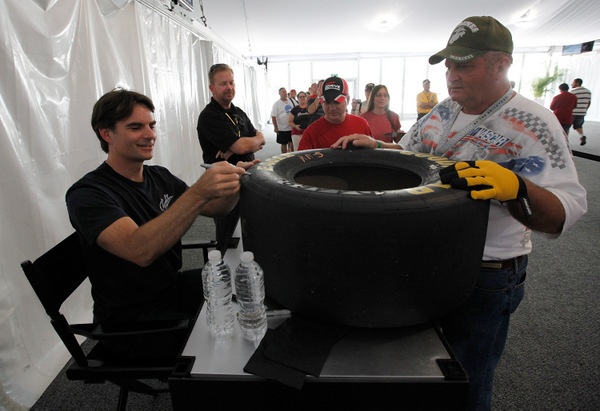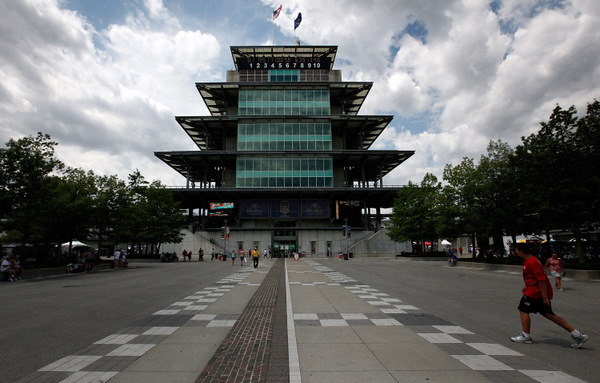It's Indy, and tires are no longer an issue? Well.......

Jeff Gordon, autographing a tire?
(Developing)
By Mike Mulhern
mikemulhern.net
INDIANAPOLIS
Tires?
That Goodyear retest at Michigan, with 28 NASCAR teams, is on the Monday morning docket.
New left-sides probably, for the August 19th Michigan 400...in the wake of last month's tire issues at what is now the fastest track in NASCAR.
And Richard Childress says NASCAR officials will probably be using that test for some testing of their own, to slow speeds. Maybe 220 mph on the straight is a bit too fast....
And here?
For a race track that's been around since 1909, Indianapolis Motor Speedway lately has proven rather difficult at times for tire companies to deal with.
There was the Michelin tire debacle at the 2005 Formula One event.
And there was the 2008 Goodyear tire debacle at NASCAR's Brickyard 400.
This weekend it's Continental Tire's day in the sun.
As sole tire supplier for the Grand-Am tour, Continental has had to develop its own unique tires for Friday's 5-1/2 hours of road racing around the IMS F1 course. In doing so the German tire giant (which uses Hoosier Tire technology in Grand-Am racing, in what is called 'a strategic alliance') discovered a lot of the problems that Goodyear has had to deal with...and then some.
One issue for Continental, which Goodyear hasn't had to face here, is the decided difference in asphalt between the 'diamond-grind' of the big oval and the different type of asphalt used on the infield part of the road course.
Throw in the four types of sports cars racing here Friday, and the possibility of rain -- and thus needed rain tires -- and Bruce Foss, Continental Tire motorsports manager, says it's been a challenging period since his first tire test here last September.
"When we did our initial test in September, we figured that would be the first of many, because we didn't expect to get instant results," Foss was saying early Friday, as Indiana's debilitating dry spell dragged on toward its third month, and as temperatures climbed toward the high 90s (11 days this month temps have topped 98 degrees).
"But I guess we did our homework properly, and we did have instant results, very positive."
However....
That test was in the relative cool, and the track was very clean, just about the MotoGP.
And when the tire company returned in June, for another test, in higher temps, "we couldn't get any rubber down in the infield," Foss said. "That test was kind of a waste....and it caused us a lot of concern.
"There was an open test scheduled for everybody July 6 and 7, and we went into that test with questions -- whether the track would take rubber or not...
"We had developed a specific tire for this track; and our September results were very acceptable. We had 100 cars showing up for the July test, and we told them to bring in tires from other tracks, because we knew that would help rubber the track in.
"But then early in the game we realized we were actually pulling the surface out of the aggregate (on the infield part of the course). It's a very tight-packed aggregate; not pebbles and stones but a very fine aggregate. And it had never really been stressed before, because it had just been paved last year prior to the MotoGP event.
"The concerns about the 'diamond-cut' banking (which bedeviled Goodyear in 2008) turned out to be not that much of a concern. We're used to deal with load-values that are greater than that, like Daytona and Homestead. So we knew the tires had the load integrity for that.
"It was just a matter of whether they'd wear.
Continental is using a high-traction compound, to provide grip through the infield segment. "And that's how we discovered what Goodyear did to mitigate its issues on the diamond-cut banking, which is so coarse -- they went to a higher traction compound, so the cars slid less, and didn't wear the tires out.
"But the infield was a challenge.
"We finally got the track rubbered in. We'd been pulling the aggregate out, and it (the asphalt bits) were going off-line. There were 'crumbs' off-line pretty bad.
"Actually as we were pulling the surface aggregate out of it, the surface was getting more coarse, and we started laying more rubber, and the track came in. We got more grip, the times kept coming down. And after two days we finally got back to where we were in September."
The asphalt on the big track has iron-slag in it, and the diamond-grinding exposed even more of that hard edge. That was the banking challenge.
The original diamond-grinding was only in certain areas, to eliminate the bumps. However that created areas where the grip changed very dramatically; so the track was then diamond-ground all the way around. And that's where the wear issues (in 2008) started for Goodyear.
Might there be an issue here Saturday with Sprint Cup and Nationwide drivers, on Goodyears, running a track rubbered in with a rival's rubber?
Possibly so.
"We find that to be true at places," Foss says.
"We run with Indy-car (which races on Firestones), and our rubber and Firestone's rubber is more compatible than anybody's rubber with Goodyear.
"Firestone guys have told me if they want to do a tire test at a track where NASCAR has just raced, they have to wait two weeks at least, and hope for rain, before they'll go there and test.
"We had a similar situation ourselves at Watkins Glen, when testing, just after the NASCAR (Goodyear) race. We were running the 'boot' (which NASCAR doesn't run), and we had grip in the boot but we were slipping and sliding around the part of the track where NASCAR had been racing.
"It took us about an hour and a half to burn that stuff off and get down to some grip."
In two weeks NASCAR and Grand-Am both race at the Glen, and Foss says Grand-Am drivers, racing after the Nationwide (Goodyear) race, expect to have issues.
"Last year (at the Glen double-header Saturday) we were slipping and sliding at the start, until we got that rubber burned off. But once that happened, we had no wear -- and the tires ran extremely hot, and we did blister some tires. It was unexpected."

© 2010-2011 www.mikemulhern.net All rights reserved.
Web site by www.webdesigncarolinas.com







Post new comment